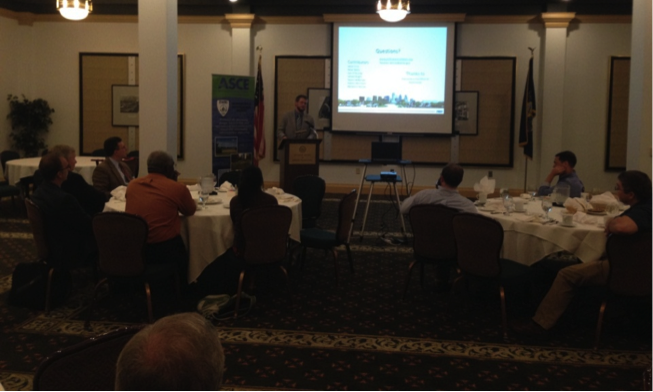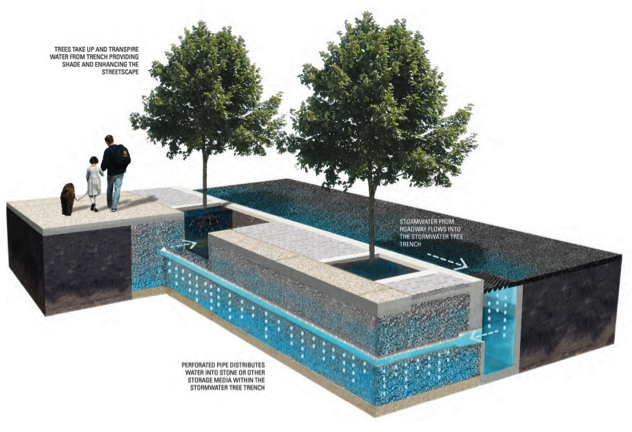 In order to mitigate combined sewer overflows, cities throughout the nation are making significant financial investments to the implementation of green infrastructure as a viable solution. Some notable cities include: Syracuse ($78 million), Buffalo ($93 million), Cleveland ($42 million), St. Louis ($100 million), Kansas City ($109 million), Milwaukee ($1300 million), New York City ($2400 million) and Philadelphia ($1670 million). The investments from the latter cities (Milwaukee, New York, and Philadelphia) are not a typo - cities are planning to invest billions on green infrastructure. The City of Philadelphia made headlines in 2011 when the Philadelphia Water Department unveiled their near 100% green infrastructure combined sewer overflow plan, “Green City, Clean Waters.” At the time, Philadelphia’s plan was the largest financial commitment ever in United States history to green infrastructure implementation as part of an EPA approved long-term combined sewer overflow solution. Milwaukee soon followed thereafter in 2013 with their plan. New York City trumped them all with their 2014 plan to spend $2400 million on green infrastructure. The nature (no pun intended) in which cities are investing their capital on the combined sewer overflow issue is clearly headed in a green direction.
In order to mitigate combined sewer overflows, cities throughout the nation are making significant financial investments to the implementation of green infrastructure as a viable solution. Some notable cities include: Syracuse ($78 million), Buffalo ($93 million), Cleveland ($42 million), St. Louis ($100 million), Kansas City ($109 million), Milwaukee ($1300 million), New York City ($2400 million) and Philadelphia ($1670 million). The investments from the latter cities (Milwaukee, New York, and Philadelphia) are not a typo - cities are planning to invest billions on green infrastructure. The City of Philadelphia made headlines in 2011 when the Philadelphia Water Department unveiled their near 100% green infrastructure combined sewer overflow plan, “Green City, Clean Waters.” At the time, Philadelphia’s plan was the largest financial commitment ever in United States history to green infrastructure implementation as part of an EPA approved long-term combined sewer overflow solution. Milwaukee soon followed thereafter in 2013 with their plan. New York City trumped them all with their 2014 plan to spend $2400 million on green infrastructure. The nature (no pun intended) in which cities are investing their capital on the combined sewer overflow issue is clearly headed in a green direction.
With such large investments being made in green infrastructure, monitoring long-term performance of constructed sites has become critical to protect the financial investments and ensure proper operation and lifespan of the facilities. To varying degrees, each of the cities above are setting aside some of the committed dollars for monitoring the local performance of green infrastructure sites.
On September 4, 2014 the Pittsburgh Chapter of the Environmental and Water Resources Institute hosted a lunchtime seminar with Stephen White, EIT M.ASCE from the Philadelphia Water Department (PWD) to give a presentation on the department’s long term green infrastructure performance monitoring program and the results to date. A key component of Philadelphia’s “Green City, Clean Waters” plan is to collect long-term performance monitoring data that would help PWD understand and characterize the functionality of the green infrastructure over time. Ultimately the data collected would help PWD determine, 1.) Best management practices for future green infrastructure design and construction, and 2.) Insights for coordinating field crews for on-going maintenance activities.
Some highlights from Mr. White’s presentation included:
- Since 2011, PWD has constructed approximately 500 green infrastructure facilities throughout the city. Out of the 500, approximately 240 of the sites are stormwater tree trenches. The remaining sites are a mixture of swales, rain gardens, pervious pavements, and infiltration trenches. A rendering provided by PWD of a typical stormwater tree trench is shown.

- Out of the 500 installations, PWD is monitoring approximately 50 sites for long term performance. Monitoring equipment consists of water level/temperature pressure transducers within the storage basins of each facility. The water level within each site is continually monitored on 5 minute increments to measure infiltration rates and volume capture. At the time of the presentation, only water quantity is being monitored by PWD (no water quality monitoring). Typical water level/temperature monitoring sensor installed at many PWD sites is shown.

- Data from seven stormwater tree trench sites were presented. Long term data from three of trenches indicate a distinct seasonal fluctuation in hydraulic conductivity with values ranging from 0.1 in/hr to 2.5 in/hr depending on the site and season. An example of the seasonal variation of the hydraulic conductivity from one of the presented trenches is shown below.

- Data from one pervious pavement installation was presented. Data indicates a decrease in infiltration rates of the pervious surface. However, the decreased infiltration rate is equal to 50 in/hr, far exceeding design storm rainfall intensities.
- Groundwater mounding and basement flooding is of major concern to PWD. PWD is currently monitoring groundwater levels in and around several green infrastructure installations to determine if infiltration practices pose potential problems for adjacent basements due to elevated groundwater levels.
Following the presentation there was a lively question and answer session with the audience. The event was attended by a diverse group of professional backgrounds such as: consulting engineers, watershed organizations, community planners, landscape architects, academia, and local government agency/sewer authority representatives. EWRI Pittsburgh will continue to bring the latest updates on green infrastructure findings throughout the nation as part of future events.
